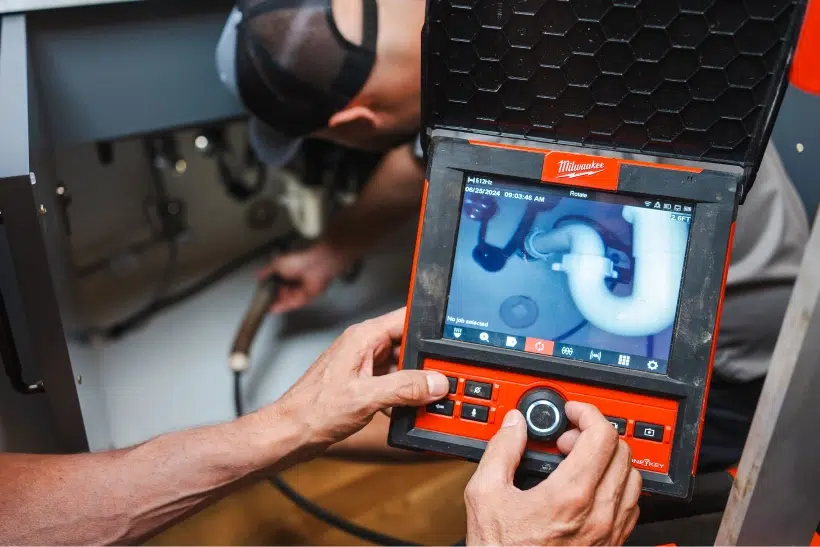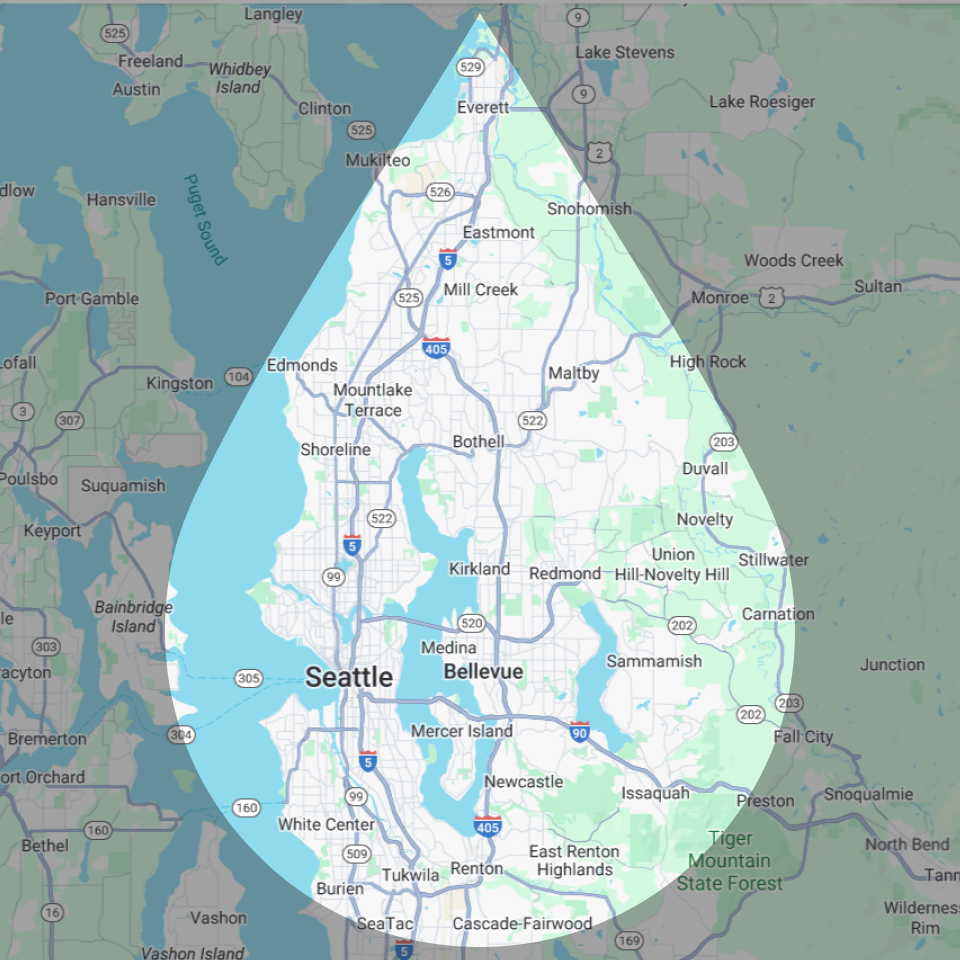A drain trap may look like a simple curve of pipe, but it’s one of the most important parts of your plumbing system. It keeps sewer gases where they belong (in the sewer), helps stop pests from coming up through drains, and sometimes even catches small items that slip down the sink. When that trap gets clogged, dries out, or starts leaking, you’ll notice—slow drains, odors, or drips under the cabinet.
This guide explains what a drain trap is, how it works, the most common problems, safe DIY cleaning methods, prevention tips, and the signs that it’s time to call a licensed pro from Ben’s Plumbing in Seattle.
What is a drain trap?
A drain trap—often called a P-trap, sink trap, or water trap—is the U- or P-shaped section of pipe beneath sinks, tubs, and showers. After each use, it holds a small pool of water. That standing water forms a seal that blocks sewer odors from entering your home. In code language, a trap in plumbing is any deliberately shaped bend designed to maintain this water seal.
Understanding How a Drain Trap Works
Water flows from the fixture into the trap and then onward to the larger drain line. Because of the trap’s shape, a bit of water remains in the bend after the flow stops. If a fixture isn’t used for a while, that water can evaporate and the trap “goes dry,” allowing odors to escape. Running water for 15–30 seconds in rarely used fixtures restores the seal.
Common Problems With Drain Traps
Slow Drains Caused by Hair, Grease, and Soap Scum
Bathroom traps collect hair and toothpaste residue; kitchen traps collect grease and food particles. Over time, buildup narrows the passage and causes clogged P-trap symptoms like slow drainage, bubbling, and occasional gurgling.
Leaks Around the Trap Connections
Traps are held together with slip-joint nuts and washers. If they loosen or the washers deform, water will drip at the joints—sometimes only when the sink is in use. Even a small, steady drip can damage the cabinet base and invite mildew.
Sewer Odors Coming From a Dry Trap
Odors from a seldom-used guest bath or basement floor drain usually mean the trap seal has evaporated. Running water to refill the trap fixes most cases. If odors persist, there may be a venting issue or a problem deeper in the line (for example, a failing sewer trap or blockage).
Corrosion or Cracked Pipes That Require Replacement
Metal traps (brass/chrome) can corrode and eventually pinhole; plastic traps (PVC/ABS) can crack if overtightened or stressed. When the body of the trap is compromised, replacement is the reliable fix rather than repeated tightening.
How to Clean a Drain Trap at Home
Gather Basic Tools: Bucket, Wrench, and Gloves
Set a bucket under the trap to catch water and debris. Have slip-joint pliers or a small adjustable wrench ready, plus rubber gloves and a towel.

Step-by-Step: Removing and Cleaning the Trap
Most homeowners can clean a sink trap in a few minutes. Here’s the safest way to do it:
- Place the bucket under the trap and lay a towel nearby.
- Loosen the two slip nuts—one at each end of the curved section. Turn counterclockwise by hand; use pliers gently if needed.
- Lower the curved section (the “P”) and empty the contents into the bucket.
- Scrub the inside with a small bottle brush, then rinse thoroughly. If you see a removable screen or baffle, clean that too.
- Inspect the washers. Replace worn or flattened washers before reassembly.
- Reassemble by hand, ensuring the trap arm lines up without strain. Hand-tighten the slip nuts, run water, and check for leaks. A small additional quarter-turn with pliers may be needed—don’t overtighten.
Tip: If space is tight, snap a photo before disassembly so you can match the alignment during reassembly. This avoids cross-threading or a crooked trap arm.
Alternative Home Remedies: Baking Soda and Vinegar
If you’d rather avoid disassembly, you can sometimes improve flow by using kitchen staples. Pour ½ cup baking soda followed by ½–1 cup white vinegar into the drain. Let it fizz for 10–15 minutes, then flush with hot (not boiling) water. This can help with light film in a kitchen sink trap or bathroom P-trap, but it won’t clear heavy obstructions or hard grease plugs.
Safety Tips – What Not to Do With Chemicals
Avoid harsh chemical drain cleaners. They can soften plastic traps, pit chrome plating, or push blockages farther down the line where they are harder to remove. Mechanical cleaning (removing the trap) or calling a professional is safer and more effective for stubborn clogs.
How to Prevent Drain Trap Problems
Prevention is easier—and cheaper—than repeated cleanings. Build these quick habits into your routine:
- Flush with hot water weekly. A kettle of hot (not boiling) water helps dissolve soap film and oils before they harden inside the trap.
- Use strainers in sinks and tubs. Mesh strainers catch hair and food scraps before they reach the trap. Empty them into the trash rather than rinsing debris down the drain.
- Never pour grease down the kitchen sink. Grease solidifies on cool pipe walls and creates recurring clogs. Wipe pans with a paper towel and put cooled grease in the trash.
- Run water in unused fixtures. Every couple of weeks, run water for 30 seconds in guest baths and basement drains to keep the trap seal intact and stop odors.
- Check for leaks. Peek under the sink monthly. Damp rings, staining, or a musty smell near the trap mean a connection needs attention.
- Schedule periodic inspections. A licensed plumber can check fittings, clear early buildup, and make sure your drainage trap and adjacent piping are healthy.
Stop wasting time—get reliable drain cleaning today.
When DIY Isn’t Enough: Signs You Should Call a Plumber
Recurring Clogs Despite Cleaning
If the drain slows again soon after you clean a P-trap, the blockage is likely beyond the trap—in the branch line or further downstream. That’s when professional drain cleaning in Seattle with tools like augers or hydro-jetting is the smarter solution.
Persistent Leaks or Damaged Piping
New washers won’t fix cracks, pinholes, or distorted fittings. If tightening never seems to stop the drip, replacing the trap (and sometimes the trap arm or tailpiece) is the long-term solution.
Strong Sewer Odors That Don’t Go Away
If the trap is full but the room still smells, there may be a venting issue, a failing house trap in older systems, or a partial blockage in the main. Odor diagnostics are faster with a pro and the right tools.
Hidden Issues Beyond the Trap – Larger Drain Line Problems
Grease caps, collapsed sections, or root intrusion won’t be visible at the trap. A professional video inspection can pinpoint the exact location and recommend repair before damage spreads.
A drain trap is small but mighty. It protects your home from odors, pests, and plumbing issues. By understanding what a drain trap is, learning how to clean it properly, and following simple preventive tips, you can keep your plumbing healthy for years.
But not every problem is a quick fix. Recurring clogs, constant leaks, or lingering odors usually signal a deeper issue. That’s when it’s best to call the experts.
Ben’s Plumbing is licensed and bonded in Washington State. If you run into stubborn drain issues or need help with repair and replacement, our team is here for you. Don’t struggle with hidden leaks or frustrating odors—contact Ben’s Plumbing for professional bathtub, shower, and sink drain services in Seattle.
Please Click to Call or Fill out our Contact Form Here



